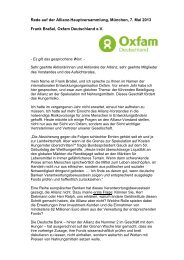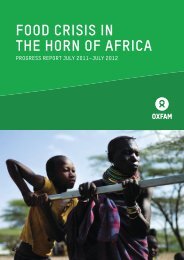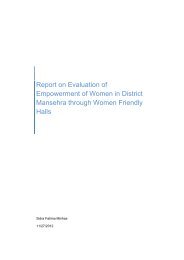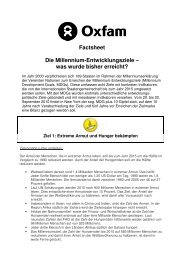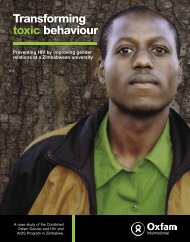No Time to Lose - Oxfam
No Time to Lose - Oxfam
No Time to Lose - Oxfam
You also want an ePaper? Increase the reach of your titles
YUMPU automatically turns print PDFs into web optimized ePapers that Google loves.
functions of policing and public services), the Afghan National Civil<br />
Order Police (the lead police organisation in counter-insurgency operations),<br />
the Afghan Border Police and the Afghan Anti-Crime Police.<br />
The more recent Afghan Local Police (ALP) is described as a ‘subpillar’<br />
of the ANP. 9<br />
The development of the ALP, as with previous community defence<br />
initiatives, is based on the premise that the ANSF does not have sufficient<br />
strength <strong>to</strong> provide security across the whole of the country, and<br />
that community members are capable of providing some first layer<br />
defence. The ALP (which is supported by the US) follows a series of<br />
community defence initiatives that have been trialled in recent years,<br />
including the Afghan National Auxiliary Police, the Local Defence<br />
Initiatives and the Afghan Public Protection Program. The programs<br />
have in all cases failed <strong>to</strong> provide effective community policing, in<br />
most cases have absorbed existing militia with almost no vetting or<br />
training of recruits, and have generally been feared by the communities<br />
they are supposed <strong>to</strong> protect.<br />
With the launch of the ALP in late 2010, some efforts have been made<br />
<strong>to</strong> address the more substantial failings of earlier initiatives. In theory,<br />
the program is established only on community request, recruits<br />
are nominated by shuras (community leadership structures) and carefully<br />
vetted, and commanders report <strong>to</strong> the district chief of police. 10<br />
Reports are mixed as <strong>to</strong> the extent <strong>to</strong> which this reflects the reality on<br />
the ground. Some communities report that it is local warlords (not<br />
‘communities’) who request the ALP; and that while selection is in<br />
some cases done through the shuras, in many cases the shuras are<br />
made up of former mujahedeen commanders who use the program as a<br />
means by which <strong>to</strong> provide their own militias with salaries and a<br />
cloak of legitimacy. 11 In other cases the shura process is circumvented<br />
al<strong>to</strong>gether, with selection done by local commanders operating independently<br />
of the shura. 12 While these criticisms are in some cases justified,<br />
it is likely that at least some of the criticism levelled at the ALP is<br />
in fact directed at local militia (arbakai) who operate in villages that<br />
have not been formally sanctioned as ALP sites, but who nevertheless<br />
claim <strong>to</strong> be and operate as ALP – often with the support of a district<br />
governor looking for a quick fix <strong>to</strong> insecurity. 13 Many communities<br />
have had devastating experiences with militias, and in many cases do<br />
not (and have been given no reason <strong>to</strong>) distinguish between the former<br />
arbakai and the newer ALP. 14<br />
The ALP is envisaged as a transitional program which will ultimately<br />
be absorbed in<strong>to</strong> the main pillars of the ANP. The force currently<br />
comprises around 5,000 recruits, in 34 ‘validated’ sites. Immediate<br />
plans are <strong>to</strong> roll out the program in 63 sites – with possible further expansion<br />
<strong>to</strong> 30,000 recruits in 100 sites. 15 There is a serious risk that<br />
with expansion, the challenge of ensuring appropriate vetting and ac-<br />
8



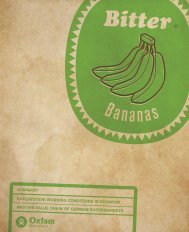
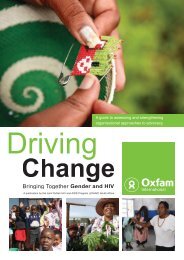

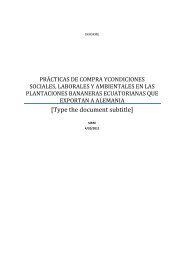
![Download: Faltposter EU-Handelspolitik [PDF 2,17MB] - Germanwatch](https://img.yumpu.com/25095854/1/190x161/download-faltposter-eu-handelspolitik-pdf-217mb-germanwatch.jpg?quality=85)
